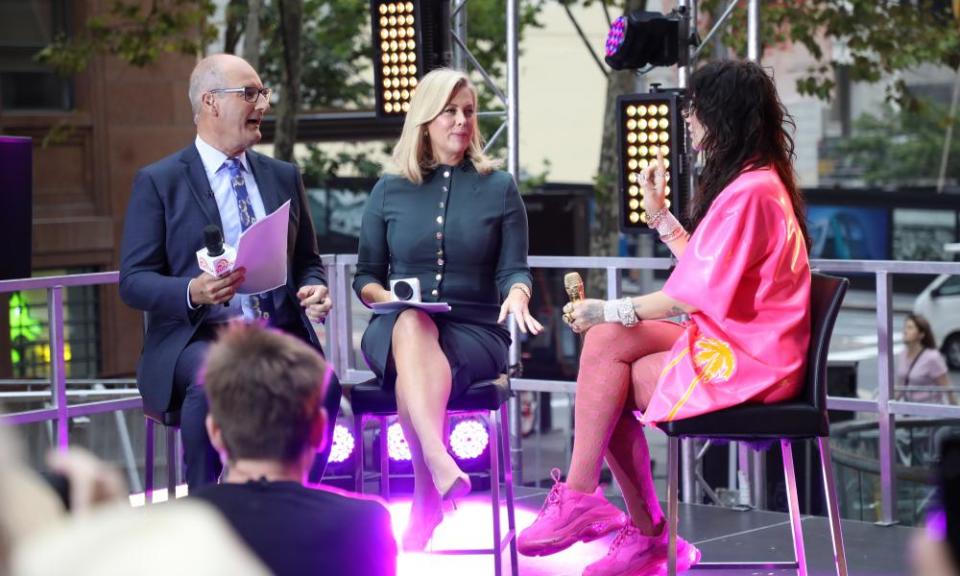Australian television a whitewash as Anglo-Celtic presenters dominate newsrooms

Australian society is a mosaic of the world’s cultures, with almost half of the nation either born overseas or with a parent born overseas and more than 300 languages spoken. But you wouldn’t get that impression watching Australian television, according to findings released by Media Diversity Australia.
Its report, Who Gets to Tell Australian Stories?, released on Monday, shows that free-to-air networks are disproportionately white compared with the wider Australian population – 76% of presenters, commentators and reporters on free-to-air networks are Anglo-Celtic despite making up only 58% of the population. Non-European and Indigenous Australians, who combined form 24% of the population, made up only 11% of free-to-air news personalities – a figure inflated by the inclusion of SBS in the report.
Antoinette Lattouf, director at Media Diversity Australia and a senior reporter at Network 10, said it was “gobsmacking” that in 2020 all-white panels still appeared on Australian TV to discuss matters such as race, migration and refugees.
Related: ‘There are no more excuses’: six industry insiders on Australian TV's problem with race
The 42-page report, backed by Google News Lab and involving researchers from the University of Sydney, Deakin University, Macquarie University and the University of Western Sydney, analysed roughly 19,000 news and current affairs items broadcast on free-to-air TV over a two-week period in June 2019.
Its breakdown revealed that all minorities were underrepresented on all three commercial networks, with the Nine and Seven Networks the least diverse. The Nine Network’s on-screen news presenters and reporters were 88% Anglo-Celtic, far ahead of Seven (72%) and 10 (67%). Australians of non-European heritage, despite making up 21% of the population, were almost entirely absent on all three commercial networks – with Nine and 10 at 3%, and Seven 5%. The ABC was only marginally better on representing non-European Australians at 9%, although its proportion of Anglo-Celtic representation was on par with nationwide demographics at 57%.
Aboriginal representation didn’t fare much better, with almost no Indigenous news personalities featuring on screen on any network in four states and one territory over the two-week period. That includes the Northern Territory, where Indigenous Australians constitute 30% of the population.
Tanya Orman, a Birri and Guugu Yimidhirr journalist and director of Indigenous content at SBS, said the structure of Australian media had its roots in the days of the White Australia policy.
“The whole [Indigenous] population was excluded from Australia under the White Australia policy, and how media has formed and evolved over its 60-plus years has reflected that exclusion.”
Minorities were also underrepresented at senior management and executive levels, the report found. National news directors across the board were all white men, it said.
The lack of diversity both in the newsroom and management means important Australian perspectives are not being heard, said Usha Manchanda Rodrigues, a senior lecturer in journalism at Deakin University who participated in the project.
“Most senior executive and board members are of Anglo-Celtic heritage, which gives rise to an argument that they do not have the lived experience of people from culturally diverse backgrounds to then put policies in place to tell different news stories.”
That exclusion also extends to geography. The report found broadcast journalists were mostly concentrated in inner Sydney and Melbourne, suggesting that suburban and rural voices were not being heard in our media discourse.
“Given news is increasingly centralised and journalists overwhelmingly live in the inner city, newsrooms are becoming even more disconnected from very multicultural suburbia and rural communities,” Lattouf said.
Nine’s director of news and current affairs, Darren Wick, disputed the report’s findings, saying the report’s methodology of “simply counting surnames on TV” was “flawed”.
“It’s disappointing that Media Diversity Australia chose not to involve the networks in the project’s research questions, methodology or in focusing it on solutions which provide greater pathways into the media.”
Lattouf said the methodology followed a similar approach taken by the Australian Human Rights Commission and “is also consistent with methodology international researchers have used in this space”.
She urged the networks not to lose sight of the bigger picture.
“Putting a mirror up to the industry may be uncomfortable for some. But it’s time to turn those feelings into action, remembering that the news product will be stronger and better connect with audiences.”
The report recommends that networks begin collecting and publishing internal data on diversity, following in the footsteps of US media.
The New York Times publishes an annual diversity report detailing its internal demographic breakdown and initiatives undertaken. Over the years, those initiatives have included employee resource groups, internal diversity and inclusion training, and investing in targeted pipelines to diversify the newsroom.
“Our mission is to seek the truth and help our readers understand the world, and that can only be done when we have a diversity of voices and perspectives informing and shaping our coverage,” said Carolyn Ryan, assistant managing editor at the Times.
Related: Australian editor-in-chief calls on colleagues to support cartoonist accused of racism
Lattouf said a more diverse newsroom might have prevented the publication of the Johannes Leak cartoon in the Australian last week, which the paper’s editor-in-chief was forced to defend against widespread accusations that it was racist.
“That this [cartoon] was put together and approved by however many levels of editorial leaders points to exactly what our report has found … that newsrooms are almost entirely Anglo-Celtic,” Lattouf said.
“Had there been more diverse people in the team, and more particularly in editorial leadership positions, this most likely would not have been published. Or, even if it was published, at the very least there would be those on the inside having really heated discussions with the editor-in-chief.”

 Yahoo Sports
Yahoo Sports 